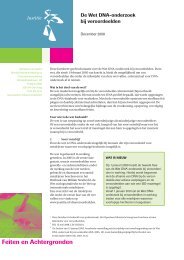INTERPOL HANDBOOK ON DNA DATA EXCHANGE AND PRACTICE
INTERPOL HANDBOOK ON DNA DATA EXCHANGE AND PRACTICE
INTERPOL HANDBOOK ON DNA DATA EXCHANGE AND PRACTICE
Create successful ePaper yourself
Turn your PDF publications into a flip-book with our unique Google optimized e-Paper software.
•need for a dna databaseOnce the basic need for the database has been established, other groups may have tobe targeted to raise their awareness of the benefits of a database and of its advantagesfor civil society. The general public should not be left out of this process. Therefore,creating a realistic awareness that <strong>DNA</strong> technology can be a very effective weapon inthe fight against crime can make the public a powerful ally, as everyone is a potentialvictim, but the potential benefits should not be oversold.•target audienceHaving identified the outcome in the eyes of those who are in a position to initiatechange, the focus of attention can then turn to identifying, and impacting on, thosetarget groups that may be able to lend their support. This reflects the experienceof using <strong>DNA</strong> Databases of certain highly developed countries in this field, and isconsidered vital to this phase of the process.The level of awareness within any criminal justice system will vary enormously andeach group of people concerned will have different requirements. The following groupscan be identified:Medical PersonnelDoctors who are employed by the police, including pathologists involved in postmortemexaminations, may be unaware of recent developments in <strong>DNA</strong> technology,and in particular the low level of biological material now required for profiling or, inappropriate cases, LCN Analysis. It is essential to ensure that all samples are collectedin the most satisfactory way, in all appropriate cases.InvestigatorsThe police will be the principal beneficiary when <strong>DNA</strong> technology is used to assistcriminal investigations. But it is not just senior police officers that should be aware bothof its potential, and of the practical aspects of crime scene sample collection, chain ofcustody safeguards and database operational requirements. Crime scene officers (bothpolice and civilian) may require initial and ongoing training. The day-to-day practicalitiesof using <strong>DNA</strong> technology as an investigative tool should also become a standard itemin the training given to new police recruits.Senior officers can be powerful allies in this regard and they can lobby politicians veryeffectively. They should therefore be strongly encouraged to create a “<strong>DNA</strong> culture”within their police services, and within wider justice departments.ESTABLISHING AN EFFECTIVE <strong>DNA</strong> <strong>DATA</strong>BASE OPERATI<strong>ON</strong> PAGE 61







